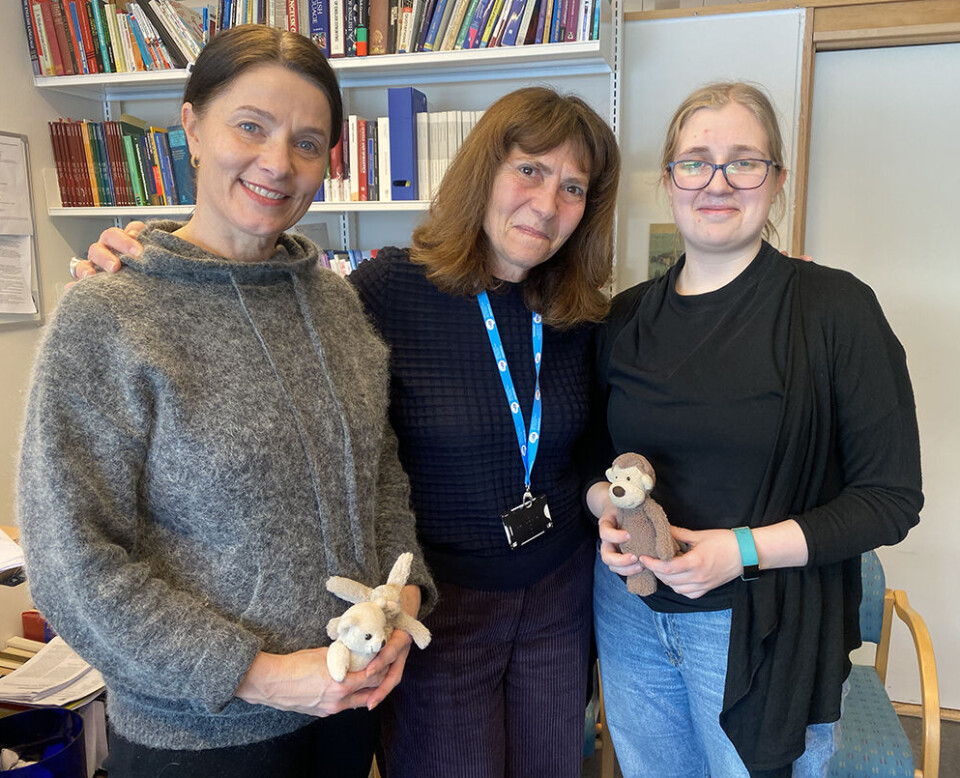THIS ARTICLE/PRESS RELEASE IS PAID FOR AND PRESENTED BY NTNU Norwegian University of Science and Technology - read more

These graphic patterns can indicate whether a child has language difficulties
Children's language development does not just happen through words.
Professor Mila Vulchanova at NTNU has, through her research, demonstrated clear associations between language development and cognitive skills.
Cognitive skills are a collective term for our ability to concentrate, pay attention, remember, our sense perception, logical reasoning and problem solving.
Her research findings challenge the established theory and tradition within linguistics. It argues that children learn to understand language and to speak largely independently of cognitive functions like spatial awareness, working memory and perception.

Found new links
Vulchanova’s latest research is based on data from the largest cohort study conducted in Norway. The Mother, Father and Child Cohort Study (MoBa) is one of the world’s largest health surveys, with data from 114,500 children, 95,000 mothers and 75,000 fathers.
Together with research colleagues from NTNU, the University of Oslo, Statped, and the University of Melbourne, Vulchanova has now catalogued new links between language development and cognitive skills.
Non-verbal tests reveal a lot about language development
Language comprehension tests are used to investigate whether children have language development challenges.
Vulchanova’s research shows that non-verbal tests are also very important for cataloguing language difficulties, what types of language challenges the child has, and in particular the severity of the language difficulties.
Researchers analysed data from more than 500 8-year-old children.
“We analysed extensive data on the language and cognitive status of children with language difficulties and compared them with children who have typical language development. The analyses show that the severity of the language difficulties can also be predicted based on cognitive markers. These are discoveries that pave new paths for research in this field,” Vulchanova says.
Cognitive markers include logical reasoning, such as recognising similarities between concepts or discovering connections between graphic patterns. Cognitive markers are catalogued based on both verbal and non-verbal tests.
How the balance between verbal and non-verbal cognitive skills affects language skills is a field that has been relatively unexplored in the past.
Which cognitive measurements and methods best predict the severity of language disorders in children is not yet well known, either.
These new research findings contribute to finding answers to these questions.
Early and correct assessment is important
An early assessment of a child’s language difficulties and correctly identifying the severity of the language difficulties is key. The right training and support can then be implemented, such as a speech therapist, and contribute to better language development.
“Our findings support the importance of measuring both verbal and non-verbal cognitive skills. In this way, we can identify which dimensions are affected and require special attention in children with language difficulties,” Vulchanova says.
She adds that their findings also point to the potential for training cognitive skills as a strategy to support language skills.
Different testing methods
One of the six testing methods used to assess the 8-year-olds is called block design and involves recognising patterns and seeing which patterns fit into the context.
Another test assesses the child’s ability to recognise similarities and serves as a bridge between verbal and non-verbal skills. A sample question could be: What is the connection between a sea and a river? Here, the child needs to understand what the words mean and also connect that they both involve water.
“We identify specific verbal and non-verbal cognitive tests that differentiate between typical children and children with language difficulties, as well as the severity of language difficulties,” Vulchanova says. “What distinguished the group with mild language impairment from the group with typical language development were the scores on the pattern recognition test (block design) and the similarity test, as well as performance on logical reasoning, vocabulary, understanding daily sequences and tasks and non-word repetition,” she says.
In the non-word test, the children have to read short words and sort them as being either real words or non-words.
“All the verbal cognitive results could predict severe language problems versus typical language development,” says Vulchanova.

Providing training to others
Three people are gathered in Vulchanova’s office to plan training sessions in language testing.
Aside from Vulchanova, they are Berit Sivertsen, educational leader at Berg kindergarten in Trondheim, and Ellen Saxlund, a lecturer at a secondary school in Bærum. Both Sivertsen and Saxlund have taken master’s degrees at NTNU’s Department of Language and Literature and have had Vulchanova as their supervisor.
They plan to hold courses for educational professionals, including kindergarten staff, people in the schools’ PPT service, speech therapists and kindergarten pedagogues and teach them methods that they can use to survey the children’s language skills.
The researchers use various objects in their course, such as a picture book, toys and stuffed animals – including a little monkey. All these items are included in the new Reynell test that Vulchanova and colleagues have adapted and standardised for the Norwegian language.

Stuffed animals are part of testing
“We perform different actions with the monkey, like making it jump, and then we ask the child to tell us what it’s doing. We’re looking for the child to identify the action and use the correct verb,” says Saxlund.
Sivertsen pulls out a rabbit from the bag of testing materials.
“We also test children’s understanding of prepositions by asking them to place the rabbit on top of, next to, or below another object,” she says.
Mila Vulchanova takes out a picture book with pictures of figures performing various actions, including a rabbit brushing a monkey. Here the children have to point out the correct pictures based on questions about what the figures are doing and who is doing what. The use of verbs in active and passive voice is key for this test.
Vulchanova stresses that language proficiency is linked to all cognitive abilities.
In their analysis, the researchers summarise:
- Our findings support the importance of measuring both verbal and non-verbal cognitive skills in order to identify the most vulnerable dimensions in children with language difficulties, but also with regard to diagnosis.
- The findings also point to the potential for targeting underlying cognitive skills as a strategy to support language skills.
- We suggest that future interventional studies focus on the effect of non-verbal cognitive skills on language development in children with language difficulties.
Reference:
Jin et al. The association of cognitive abilities with language disorder in 8‐year‐old: A population-based clinical sample, International Journal of Language & Communication Disorders, 2023. DOI: 10.1111/1460-6984.12861
Read more content from NTNU:
-
More than 120,000 Norwegians suffer from work-related anxiety
-
Forever chemicals affect ducklings' genes while they are still in the egg
-
Why are pregnant women in Norway so worried?
-
Politics on Facebook: Populist parties choose divisive issues on purpose
-
Social media is connected to cyberbullying – but not how we thought
-
Forskere ved NTNU får nesten 24 millioner av EU for å lage nye strømomformere





































